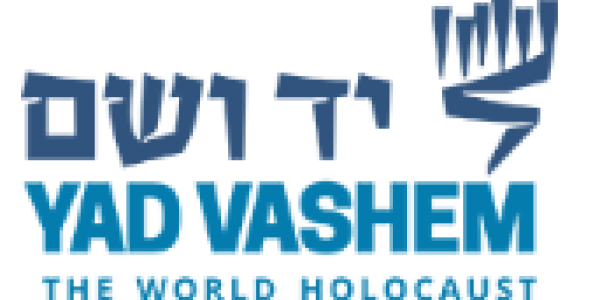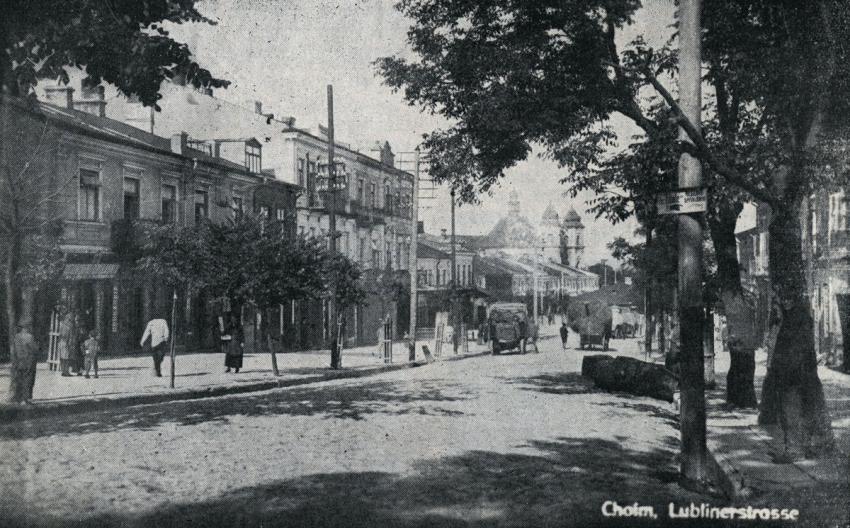Holocaust Martyrs' and Heroes' Remembrance Day 2024
A Lost World: The Destruction of the Jewish Communities
05/05/2024 | Na stronie od 22/01/2024

Source: Yad Vashem
"If we wish to live and to bequeath life to our offspring, if we believe that we are to pave the way to the future, then we must first of all not forget."
Prof. Ben Zion Dinur, Yad Vashem, 1956
About Holocaust Remembrance Day
Overview:
Holocaust Martyrs' and Heroes' Remembrance Day 2024 A Lost World: The Destruction of the Jewish Communities
Holocaust Martyrs' and Heroes' Remembrance Day (Yom Hashoah in Hebrew) is a national day of commemoration in Israel, on which the six million Jews murdered in the Holocaust are memorialized. It is a solemn day, beginning at sunset on the 27th of the month of Nisan and ending the following evening, according to the traditional Jewish custom of marking a day. Places of entertainment are closed and memorial ceremonies are held throughout the country. The central ceremonies, in the evening and the following morning, are held at Yad Vashem and are broadcast live. Marking the start of the day-in the presence of the President of the State of Israel and the Prime Minister, dignitaries, survivors, children of survivors and their families, gather together with the general public to take part in the memorial ceremony at Yad Vashem in which six torches, representing the six million murdered Jews, are lit. The following morning, the ceremony at Yad Vashem begins with the sounding of a siren for two minutes throughout the entire country. For the duration of the sounding, work is halted, people walking in the streets stop, cars pull off to the side of the road and everybody stands at silent attention in reverence to the victims of the Holocaust. Afterward, the focus of the ceremony at Yad Vashem is the laying of wreaths at the foot of the six torches, by dignitaries and the representatives of survivor groups and institutions. Other sites of remembrance in Israel, such as the Ghetto Fighters' Kibbutz and Kibbutz Yad Mordechai, also host memorial ceremonies, as do schools, military bases, municipalities and places of work. Throughout the day, both the television and radio broadcast programs about the Holocaust. In recent years, other countries and Jewish communities have adopted Yom Hashoah, the 27th of Nisan, to mark their own day of memorial for the victims of the Holocaust.
Holocaust Martyrs' and Heroes' Remembrance Day 2024 will be on Monday, May 6th. The State Opening Ceremony will be held at Yad Vashem on Sunday, May 5th at 20:00.
Holocaust Martyrs' and Heroes' Remembrance Day Through the Years
Holocaust Martyrs' and Heroes' Remembrance Day (Yom Hashoah in Hebrew) is a national day of commemoration in Israel, on which the six million Jews murdered in the Holocaust are memorialized. The central ceremonies, in the evening on the 27th of the month of Nisan and the following morning, are held at Yad Vashem and are broadcast live.
The Central Theme 2024
A Lost World: The Destruction of the Jewish Communities
The Jewish community, a unique, autonomous social unit that characterized Jewish existence in the Diaspora through the ages, was dealt a fatal blow by the Holocaust. Thousands of prewar Jewish communities had served as a fundamental and critical framework in the lives of the Jewish people.

View of Lublin Street in Chełm, prewar
The Rabbinic adage, "All Jews are responsible for one another" was not a mere recommendation, but rather a practical axiom according to which traditional Jewish communities shaped their institutions and by which their leaders abided. A community's authority encompassed all aspects of life and mandated the complete allegiance of its members. From the moment of their birth until their final breath, in joy and in sorrow, Jews were affiliated with their communal institutions, which provided them with an identity, and a social, educational, religious and economic network via such established organizations as synagogues, courts of law, Mikvaot (ritual baths), and shelters for the sick and the impoverished. Community figures represented their members vis-à-vis the authorities and served as a conduit of information from those authorities back to the community. Despite the singularity of each Jewish community in Christian Europe and the Islamic countries, there were marked similarities in the structure and operation of the various communities.
The modern era brought with it dramatic changes in the characteristics and behavioral patterns of the Jewish community, due to the forces of modernization and the intervention of governmental authorities. In many parts of Europe and the Mediterranean basin, a new form of Jewish community emerged: a "congregation of ritual observance", focused primarily upon the accommodation of its members' religious requirements, alongside provision of their social and economic needs. This shift strengthened the status of the Rabbi, and the importance of synagogues and Batei Midrash (houses of learning), which became the principal communal institutions.
Alongside such religious communities, there evolved, from the end of the 18th century and henceforth. alternatives to the traditional community. In Eastern Europe, Hasidic courts arose and regional Yeshivot (Talmudic academies) were established, the first of which opened in Volozhin in 1803. At the same time, figures from the "Jewish Enlightenment" movement labored to provide reformed social networks to the Jewish community. These communities did not require official recognition by the authorities, as their strength derived from the traditional connection between religious faith and social structure.
From the mid-19th century, a diverse ideological, political and national consciousness was awakened amongst the Jews, giving rise to a new sense of collective identity. This consciousness influenced the nature of the Jewish community and was expressed in the creation of new voluntary social frameworks that served as a modern, secular alternative to religious communal existence, in effect creating a civic society.
On the eve of World War II, the Jewish communities in the shtetls, mellahs, villages, towns and cities in the East and West were replete with philanthropic institutions, political parties, welfare and mutual assistance frameworks, representative bodies that liaised with the authorities and non-Jewish society, Jewish trade unions and immigrant organizations. These in turn facilitated the proliferation of educational and cultural institutions, youth movements, sports clubs, libraries, newspapers, theaters, orchestras and choirs. This abundance existed alongside the traditional Jewish institutions: synagogues, religious courts, Mikvaot, educational frameworks such as the Heder (Hebrew school), Talmud Torah (elementary school) and Beit Midrash, charitable institutions and the Hevra Kaddisha (burial society).
With the rise of the Nazis to power in Germany, and subsequently upon the establishment of German hegemony over most of Europe and large parts of North Africa, Jewish society was forcibly plunged into an extreme reality. Faced with persecution and daily terror, the Jews fought tenaciously to preserve their physical and spiritual existence. Their sense of shared destiny, mutual responsibility and solidarity persisted as the cornerstones of Jewish communal life, even during the Holocaust.
The establishment of the ghettos in Eastern Europe, as a consequence of Germany's policy of segregation and isolation of the Jews, turned each Jewish community into a distinct, closed administrative unit, cut-off one from the other communities and from their surroundings. Throughout the conquered lands, many veteran Jewish leaderships ceased functioning, and were replaced by new communal administrations, imposed by the Germans. From then on, community leaders were forced to implement the orders of the German Nazi regime, and were made responsible for a wide range of functions that had routinely been handled by governmental and municipal institutions: food supply, employment, housing, health and sanitation, and even spheres that had previously been antithetical to the Diaspora Jewish heritage, such as the police and prisons. At the same time, the community continued to bear its previous responsibilities of accommodating religious needs, and providing education, welfare and burial services.
The systematic murder campaign waged against the Jews by the Nazis and their collaborators inflicted utter devastation upon thousands of communities in the German-occupied areas of Europe and North Africa; entire communities were decimated, and in many cases were totally obliterated.
The post-Holocaust Jewish world found itself in a jarringly harsh new reality: millions of Jews had been murdered, and with them, an array of venerable communal institutions and a wealth of Jewish civilization had been obliterated. In many locations, survivors attempted, as best they could, to reconstitute and renew their communities. In Israel and other countries to which survivors immigrated, many formed Landsmannschaften, associations of survivors from specific places that served as communities of remembrance for many years after most of their original members had been murdered, their institutions destroyed and their survivors dispersed all over the world.
Hundreds of destroyed communities were commemorated in Yizkor (memorial) books. This was a monumental enterprise initiated by Holocaust survivors, together with community members who had left Europe before World War II in order to commemorate a glorious chapter of Jewish history: the Diaspora community.
The legacy of the Jewish community is one of the most magnificent and cherished treasures that Jewish history has bequeathed to us. The destruction of the communities during the Holocaust is a deep wound inflicted upon the body and soul of the Jewish people. Delving into the history of the Jewish community and studying its destruction helps to illustrate the enormity of the calamity and the catastrophic loss suffered by the Jewish people during and following the Shoah.
Torchlighters
Each year, six Holocaust survivors are chosen to light torches in memory of the six million Jews who were murdered during the Holocaust.
Each year, during the official Holocaust Martyrs' and Heroes' Remembrance Day ceremony that takes place at Yad Vashem, six torches, representing the six million Jews, are lit by Holocaust survivors. The personal stories of the torchlighters reflect the central theme chosen by Yad Vashem for Holocaust Remembrance Day. Their individual experiences are portrayed in short films screened during the ceremony. All of these films and individual stories can be accessed (by country or year of ceremony) on this page.
Names
- Names for Name-Reading Ceremonies
- The Central Database of Shoah Victims' Names
Yad Vashem, together with its partners, has collected and recorded the names and biographical details of millions of victims of systematic anti-Jewish persecution during the Holocaust (Shoah) period. More than four million eight hundred thousand of the near six million Jews murdered by the Nazis and their accomplices are commemorated here. This database includes information regarding victims of the Shoah: those who were murdered, many whose fate has yet to be determined as well as some who survived.
The names of more than one million of those who were murdered remain unknown – and time is running out. It is our collective moral imperative to persist in our efforts to recover their names and restore their identities.